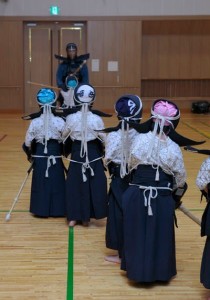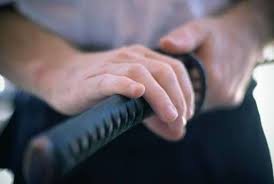It is with a heavy heart that I write this final post on behalf of my beloved father, Geoff Salmon Sensei, who passed away on the 9th November 2018, joining my mother, his dear wife, Valerie who passed in July. He was a true warrior until the end – and despite the ferocity of his final opponent, cancer, he never let it conquer his fighting spirit, dignity and inimitable sense of humour.
As you will most probably know, Dad dedicated his life to mastering and teaching the art of Kendo. A pastime which began in his teens as a hobby and evolved in to a true passion and an integral part of his existence over the next 51 years. Even in the final weeks of his life, despite his rapid decline in health and fragility he still mustered the energy from deep within, fuelled by his unwavering love for the sport, to take Keiko in Spain, sit for hours on a grading panel and visit Mumeshi Club almost every week. Even after slipping in to unconsciousness for 24 hours, whilst I kept a bedside vigil fearing the worst, he awoke suddenly, smiled excitedly and said “Is it Sunday yet? Can you drive me to Kendo now?”…and in case you’re wondering, he wasn’t joking!
能ある鷹は爪を隠す– Nô aru taka wa tsume wo kakusu
Translation: The skillful hawk hides its talons
I often think of this proverb when I remember my father – A hawk who is a skilled hunter, hides his talons from his prey. One of the many Japanese quotes that serves as a reminder to stay humble. In fact, it was due to his great humility that many of his friends and family, (ashamedly myself included) underestimated the sheer magnitude of his many achievements throughout the years until he passed. From holding the position as Chairman of the British Kendo Association to directorship of the company set up to run the highly successful 2004 world kendo championships in Glasgow. Running and translating at kendo seminars around the world. Being honoured as an International Referee at both national, European and world championships. Judging at most UK kendo grading panels. Becoming a successful author (…and even a stint on a prime-time television show ‘The Games’ assessing/lamenting celebrity kendo attempts!) And, of course, attaining the prestigious rank of 7th Dan Kyoshi – of which there is currently no higher grade in Europe.
All this aside however, I personally believe his biggest accomplishment is how many kendokas of all ages he inspired around the world and the passion he ignited in others for the sport. The legacy of which can be clearly seen in the hundreds of heartfelt messages and wonderful recounted memories that I have received in various forms since his passing!
I know he was very much hoping to write a final goodbye to you all but unfortunately time was against him. On his behalf, however, I would like to sincerely thank you for supporting his blog throughout the years (which I will continue to keep on-line) and share with you his final wish – ‘to extend the Kendo community and help engage the next generation’.
Despite not being a kendoka myself, it is my hope to preserve my fathers’ legacy (as Terry Pratchett so eloquently put it .. “No one is actually dead until the ripples they cause in the world die away…” ) and help to fulfil this wish. Exactly how I plan to do this I am yet uncertain but I am sure with your help this can and will be achieved!
On behalf of both myself and my father, I would like to thank the international Kendo community for all your support and wish you all a healthy, happy and prosperous new year. I hope you will join me this New Year’s Eve and raise a glass to a wonderful father, husband, grandfather, teacher and friend – a man who truly embodied the ‘spirit of the warrior’, Geoff Salmon Sensei. Gone but never forgotten!
With best wishes to you all,
Cassie














